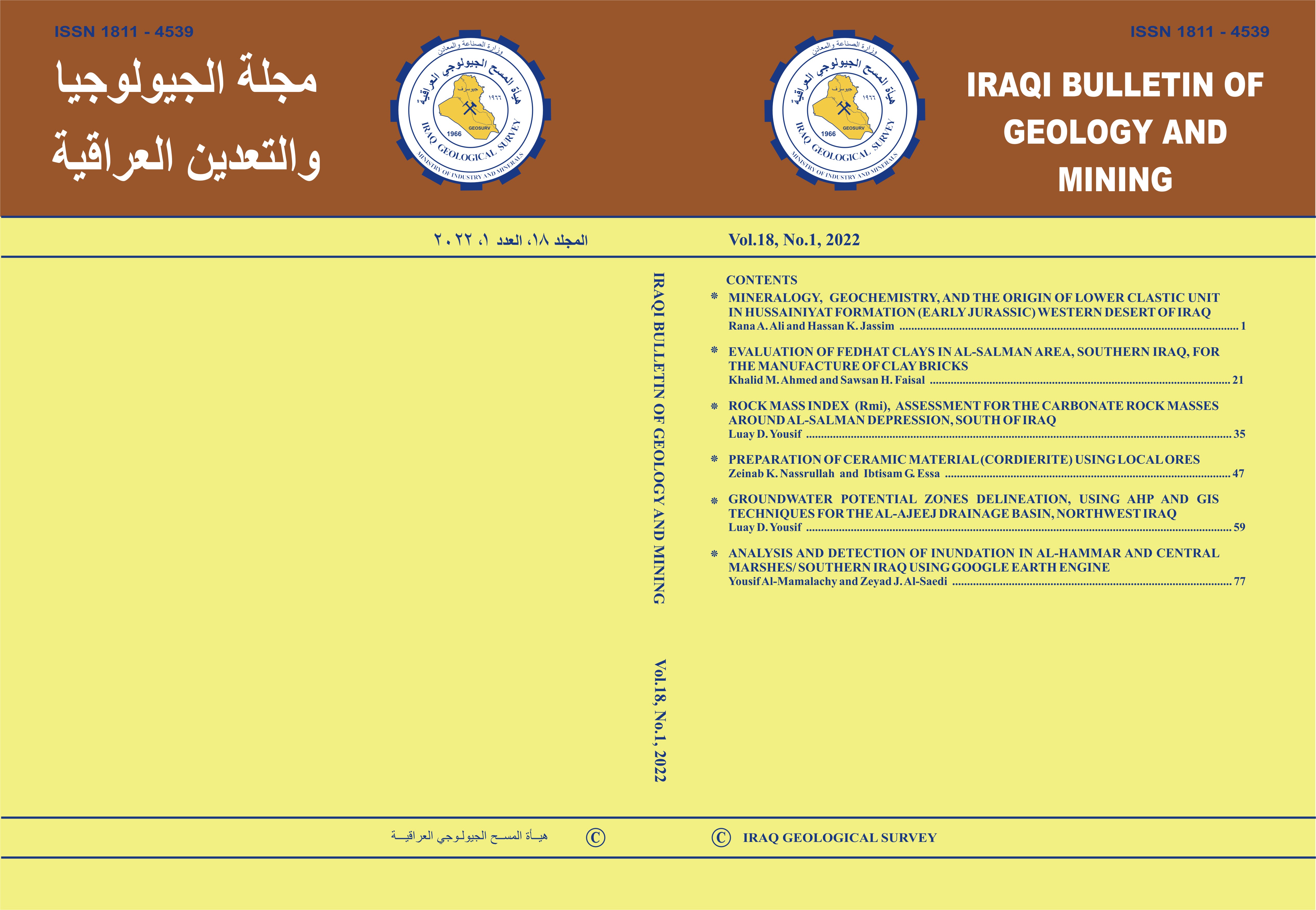Abstract
A mineralogical and geochemical study has been done on (20) Hussainiyat Formation (Early Jurassic) samples in western Iraq. Mineralogical analysis of clays by X-ray diffraction (XRD) shows that the predominant clay mineral is kaolinite and traces of montmorillonite-illite mixed layer with palygorskite. The non-clay minerals are mostly quartz, goethite, hematite, and anatase. Heavy minerals were separated from (sandstone) clastic samples and studied by both polarized and reflected microscopes. These heavy minerals are detected in fewer than 1% quantities and consist of silicates and oxides. The most common of these mineral grains are stable heavy minerals ZTR (zircon, tourmaline, rutile) and apatite, staurolite, and garnet, which indicate that the acidic granite rocks with almost metamorphic rocks were a source of kaolinite. In a geochemical study by XRF, claystone samples were analyzed for SiO2, Al2O3, TiO2, Fe2O3, MgO, CaO, Na2O, K2O, MnO, P2O5, and L.O.I. kaolinite (claystone) of the Hussainiyat Formation contains a high concentration of iron, which is interbedded with kaolinite as hematite, goethite, and limonite. Kaolinite occurs as kaolinitic pellets and as nuclei of the majority of ironstone ooids and pisoids, together with the alternating concentric laminae of their cortices. Manganese is associated with the kaolinite of the Hussainiyat due to its high iron content.
The present study showed that the kaolinite deposits within the Hussainiyat Formation are less mature than other clays (montmorillonite-illite mixed layer and palygorskite), because the Hussainiyat Formation suffered from less intense chemical weathering, leading to the dissolution of only alkalis and earth alkali metals but not iron. However, the alumina is still stable with li, due to their high resistance, the alumina is still stable with little silica to form kaoliniteintensive chemical weathering, and kaolinite builds by Si and Al. This is because these two oxides are, typically, stable within different physical and chemical weathering. After kaolinite, the rest only gibbsite and boehmite bauxite mineral at the end of the intensive chemical weathering.
The present study showed that the kaolinite deposits within the Hussainiyat Formation are less mature than other clays (montmorillonite-illite mixed layer and palygorskite), because the Hussainiyat Formation suffered from less intense chemical weathering, leading to the dissolution of only alkalis and earth alkali metals but not iron. However, the alumina is still stable with li, due to their high resistance, the alumina is still stable with little silica to form kaoliniteintensive chemical weathering, and kaolinite builds by Si and Al. This is because these two oxides are, typically, stable within different physical and chemical weathering. After kaolinite, the rest only gibbsite and boehmite bauxite mineral at the end of the intensive chemical weathering.
Keywords
Clays; Non-clay minerals; Heavy minerals; Major elements; Ironstones
Abstract
نفذت الدراسة المعدنية والجيوكيميائية على (20) عينة من تكوين الحسينيات (الجوراسي المبكر) في غرب العراق. أظهر التحليل المعدني للمعادن الطينية بواسطة جهاز حيود الاشعة السينية (XRD)، ان المعدن الطيني السائد هو معدن الكاؤولينايت كما تم العثور على نسب قليلة من المعادن المختلطة من الالايت – مونتمورلونايت مع نسبة أقل من الباليغورسكايت. المعادن غير الطينية هي في الغالب الكوارتز والجيوثايت والهيماتايت والاناتيز. تم فصل المعادن الثقيلة من العينات الفتاتية (الرملية) ودراستها بواسطة كل من المجهر المستقطب والمجهر العاكس. المعادن الثقيلة موجودة بتراكيز اقل من 1%، توجد بشكل اساسي على شكل سليكات وأكاسيد، وهذه الحبيبات المعدنية الشائعة تشمل المعادن الثقيلة المستقرة (الزركون و التورمالين والروتايل) والابتايت والستورولايت والعقيق. يشير وجود معادن ثقيلة مقاومة للتجوية مثل الزركون والاناتيز الى ان صخور الجرانيت الحمضية مع صخور متحولة غالبا كانت مصدرا للكاؤولينايت. بالنسبة للدراسة الجيوكيميائية بواسطة XRF. تم تحليل العينات لـ SiO2 و Al2O3 و TiO2و Fe2O3 و MgO و CaO و Na2Oو K2Oو MnOو P2O5و L.O.I. يحتوي الكاؤولينايت في تكوين الحسينيات على تركيز عال من الحديد المتداخل مع الكاؤولين مثل الهيماتايت والجيوثايت والليمونايت. يقع الكاؤولينايت على شكل دمالق كاؤولينيتية وكنوى لاغلبية سرئيات ودمالق الصخور الحديدية جنبا الى جنب مع صفائح متحدة المركز متناوبة مع القشرة. يرتبط المنغنيز مع الكاؤولينايت في تكوين الحسينيات بسبب احتوائه على نسبة عالية من الحديد. أظهرت الدراسة الحالية ان رواسب الكاؤولينايت في تكوين الحسينيات أقل نضوجا من الاطيان الاخرى (معادن مختلطة مونتمورلونايت والايت)، لان تكوين الحسينيات قد عانى من التجوية الكيميائية الاقل شدة أدى الى اذابة وانحلال القلويات والفلزات القلوية الارضية فقط ولكن ليس الحديد. ومع ذلك، لاتزال الالومينا مستقرة مع القليل من السليكا لتكوين الكاؤولينايت بسبب مقاومتها العالية. دائما ما يكون الكاؤولين ناتجا عن التجوية الكيميائية الشديدة، ويتكون الكاؤولين بواسطة Siو Al. هذا لان هذين الاوكسيدين يكونان عادة مستقرين في ظروف التجوية الفيزيائية والكيميائية المختلفة. يكون الباقي فقط، بعد معدن الكاؤولين, معدن الجيبسايت والبوكسايت البوهميت في نهاية التجوية الكيميائية الشديدة.
